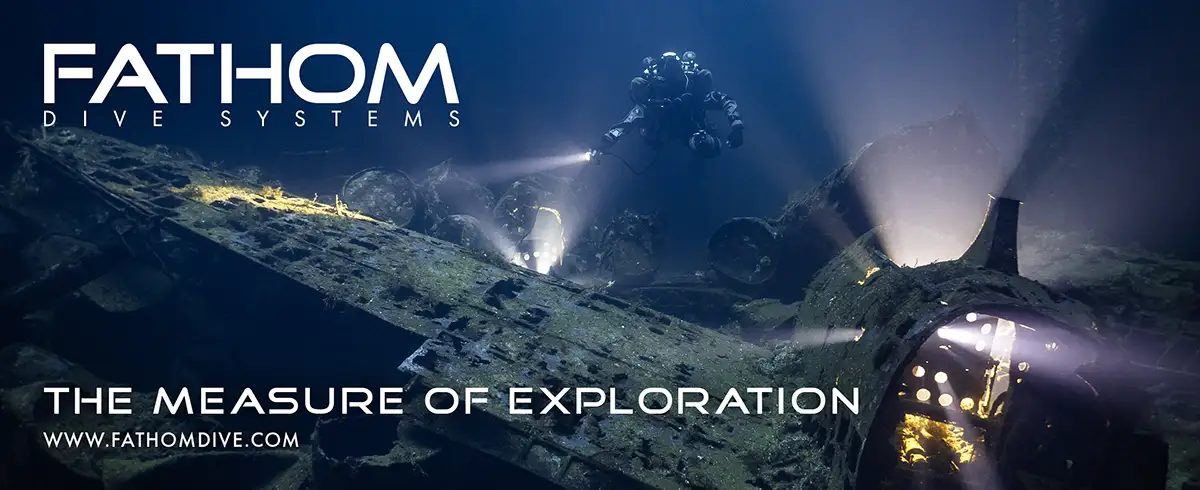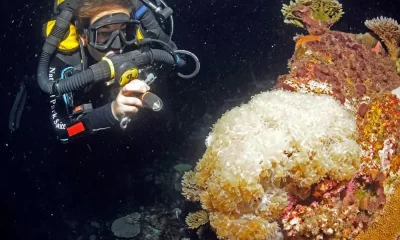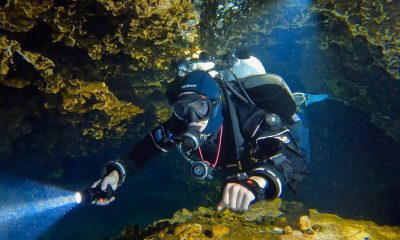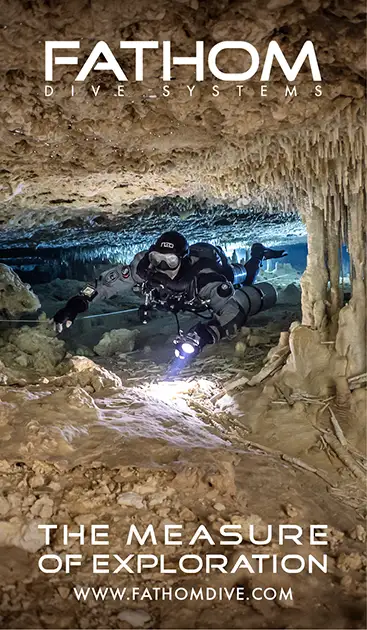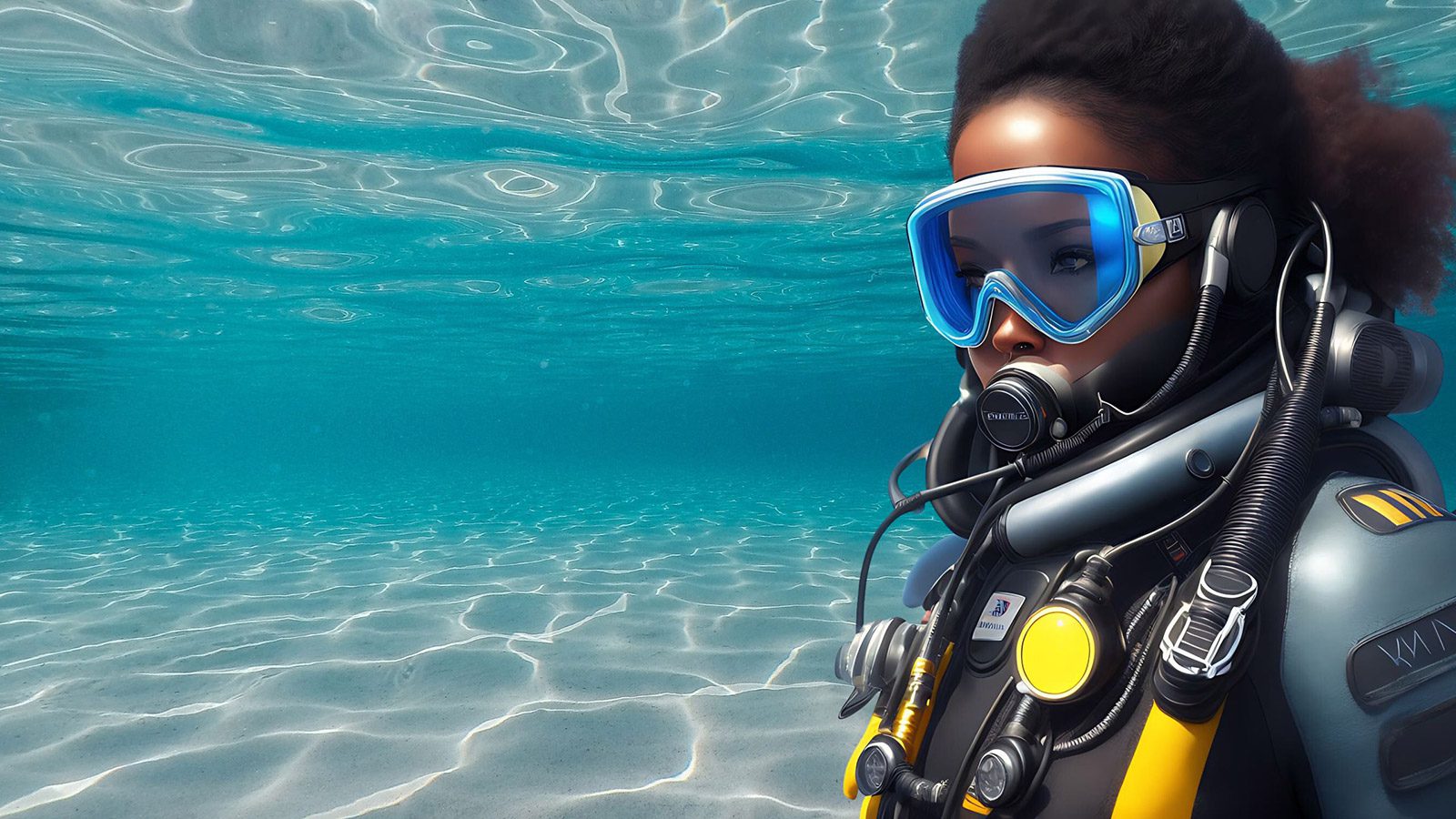
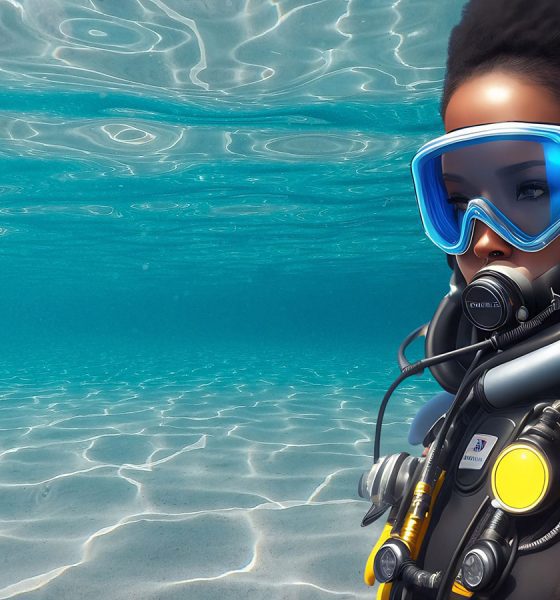
Community
We Sea You!
While we acknowledge that today, the tech community is largely older, male and white, Georgina Brown, founder of Bardo Inclusive, proposes that we all can play a role in encouraging cultural and structural change to ensure that diverse divers are seen, heard, recognised, and rewarded. She argues by doing so, we would not only encourage the future relevance and resilience of the diving industry, but also expand its appeal into untapped markets. Besides that, it’s simply the right thing to do.
by Georgina Brown. Images courtesy of Bardo Inclusive unless noted. Lead image: AI image of a Black diver created by G. Brown.
“You think you’re thinking your thoughts. You are not. You are thinking the culture’s thoughts.”
This quote from philosopher Jiddu Krishnamurti highlights a challenge facing many sectors within society.
Where we find a group of individuals with similar life experiences, the lens through which they see the world reflects that majority’s lived experience. If everyone in that group of like-minded individuals identifies as one gender, race, sexual identity, cultural heritage, and/or socio-economic status, this inadvertently creates a culture that sets up invisible barriers to people with minority identities.
In the world of diving, it’s easy to see the results of these barriers in action. If you were to visit any diving event—especially those pitched at higher levels of diving—you would see said results in stark clarity. More often than not, you would observe the vast majority of individuals that look, think, and identify in similar ways: the majority mirrors each other’s backgrounds and lived experiences. For the future relevance of diving, the question is not who is represented but who is missing, and why?
We need only this visual indicator to know that representation of divers does not reflect the diversity of our wider society. This lack of representation limits business, research, and personal opportunities. While homogeneity is rarely intentional, it is often unseen or perhaps shrugged off as “just the way things” are, or possibly dismissed as unimportant.
Sadly, these barriers (and the resulting cultural homogeneity) often prevent highly competent individuals from realising their diving goals as well as denying the diving community diversity of thought, new imaginative solutions, and ultimately the opportunity for fresh discoveries. Meritocracy is a fallacy when diversity and inclusion are not addressed.
Meritocracy is a fallacy when diversity and inclusion are not addressed.
To truly address diversity and inclusion, efforts to do so need to be threaded through every aspect of a community’s work. Diversity is not a numbers game; it is not about simply increasing representation alone (although representation is important). Diversity efforts are about ensuring true inclusion and recognising barriers within our processes, policies, practices, and culture: barriers that hold us all back.
What does a typical diver look like and why is that typical?
“You can’t be what you can’t see.”
—Marian Wright Edelman
LEARNING AND UNLEARNING
Human complexity and uniqueness are our species’ strengths. And, as we move through life, we become aware of beliefs, truths, actions, and ideas that (though perhaps well-intended) have a negative impact on ourselves and others.
This awareness, while often uncomfortable, is necessary–both for personal growth and for social progress. In the same way others’ lived experiences, diverse thinking, and unique ideas can help us think about things in a new light, it is reflection that allows us to explore our thought patterns. This is something I hope this article will prompt readers to do, and I urge you to read it with an open mind and heart as we learn and unlearn together. Let’s stretch our concepts of how things are.
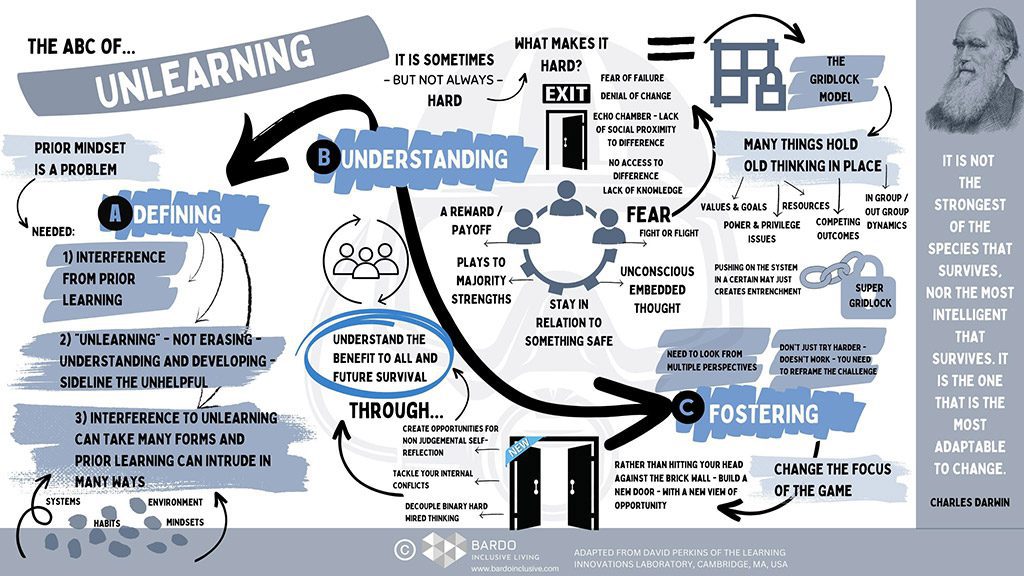
CONTINUOUS CHANGE
If there is one thing that is certain in life, it is that things change. Everything is transient, and the needs of society are changing as the world becomes increasingly diverse and individuals explore their identities.
People want to be seen as their authentic selves, not be forced to hide who they are or to conform to a single, default way of being and living. This effort to be authentic has led to increased awareness of gender identities outside the binary, more neurodivergent ways of thinking, beyond expectations of those with unique physical abilities and diverse cultural needs—to name a few.
“Progress is impossible without change, and those who cannot change their minds cannot change anything.” —George Bernard Shaw
To remain relevant in this changing world, there is a need to recognize this constant change and adapt. This requires all of us to self-reflect and think of new approaches, new products, and new research that can help us meet our changing needs. Sadly, our brains are often highly resistant to change.
A NEUROSCIENCE THEORY
Βest selling author and researcher Dr. Joe Dispenza proposed a scientific basis for the idea that our subjective minds have an effect on our objective world, along with the proposal that we have a natural ability to change the brain and body by thought alone. He believes that thoughts have consequences so great that they can create our reality.
As Dr. Dispenza writes in his book, Breaking the Habit of Being Yourself: How to Lose Your Mind and Create a New One, “If we unconsciously live by a set of memorised behaviours, thoughts, and emotional reactions which are all running like computer programs behind the scenes of our conscious awareness, then all of our personal experiences are literally reflected within the networks of neurons that make up our brains. And since our feelings merely reference our record of previous experiences, we’re always thinking in the past. If our brains are so habituated to memorising the chemical records of our past experiences, then it grows attached to the resulting emotional responses based solely on these records.”
Furthermore, “Psychologists theorise that by the time we’re in our mid-30s, our personalities are formed. That means that those of us over 35 have memorised a select set of behaviours, attitudes, beliefs, emotional reactions, habits, skills, associative memories, conditioned responses, biases, and perceptions that are now subconsciously programmed within us. About 95% of who we are by midlife is a series of subconscious programs that have become automatic.”
WE ARE 95% ON AUTOPILOT
“If you change the way you look at things, the things you look at change.” —Wayne Dyer
Donald Hebb was a Canadian psychologist who is commonly known as the father of neuropsychology. His work provided the basis for numerous further scientific discoveries, and he has transformed our understanding of cognitive processes. His work established “Hebb’s Rule,” which describes how when a cell persistently activates another nearby cell, the connection between the two cells becomes stronger. This can be expressed as when we repeat an experience over and over, the connection between the activated brain cells is strengthened.
This idea is frequently summarised as “neurons that fire together, wire together,” which can be seen in many aspects of our daily lives and can be extended to support the idea that we become neurochemically attached to the conditions in our lives. We understand and experience life through our “known” culture which causes us to repeat thought patterns and belief systems often without question, thus enabling discrimination. And discrimination negatively impacts diversity and inclusion, which negatively affects a rich, full life.
BREAKING THE HABIT OF DISCRIMINATION
Developed by world-renowned researcher, Unyte Health’s Chief Scientific Advisor, Dr. Stephen Porges, “Polyvagal Theory” focuses on what is happening in the body and the nervous system, and explains how our sense of safety, danger or life threat can impact our behaviour.
Polyvagal Theory supports the idea that when patterns and belief systems are challenged by new, unknown thinking, images, or behaviours, our vagus nerve triggers the fight-or-flight response. As a result, we often unconsciously dismiss, discredit, block, or silence any thing or person that does not fit into our known view.
The vagus nerve runs down our spine and links into the central nervous system, thus triggering a physical as well as an emotional response to anything that challenges our default thoughts and beliefs. However, without those new, yet-unknown ways of thinking, we limit how we can progress, develop, and create innovative approaches, discoveries, and ideas. This creates an unintentionally limited homogenous groupthink approach.
A pragmatic, kind, and open approach to diversifying thought is essential to ensure the future relevance and resilience of diving in an increasingly diverse world.
Experiencing something previously unknown and unexpected,—such as the beautifully diverse superhero graphics used at the recent Rebreather Forum 4—can make us feel uneasy. Challenging the status quo forces us to self-reflect, question our beliefs, and ultimately acknowledge our part in maintaining a discriminatory status quo.
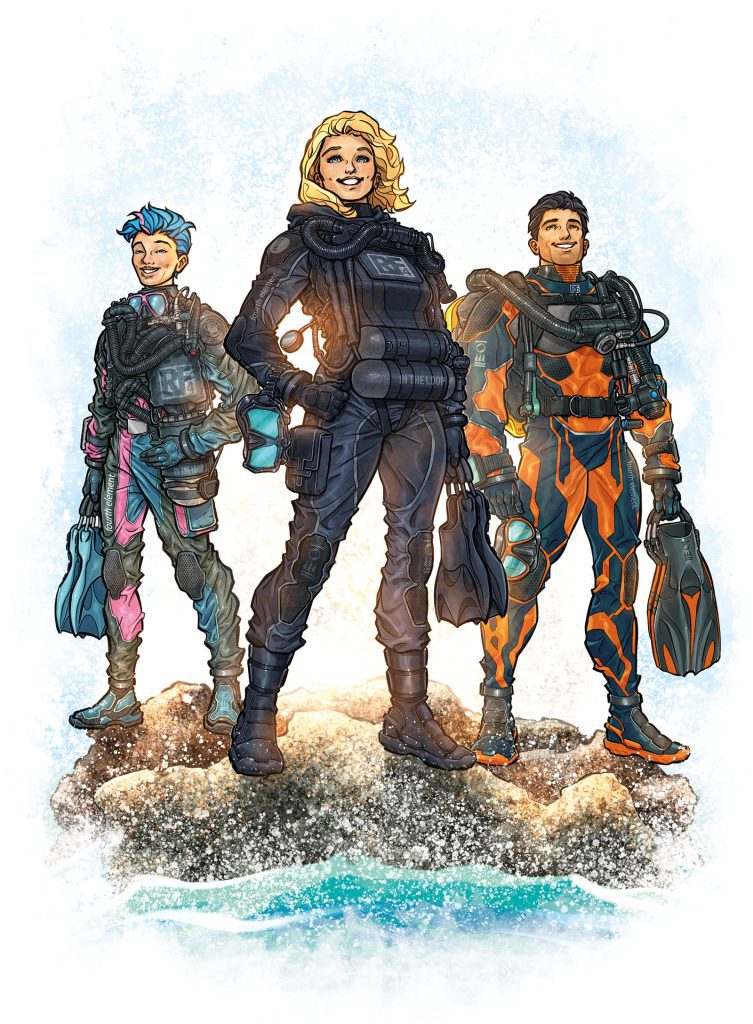
In fact, when the illustrations were first shared, they received some kickback; some viewers scoffed at the premise of female military divers or non-binary technical divers and called it, “Woke.”
This response demonstrates the extent of homogeneity in diving culture and willful or involuntary blindness to the past, especially considering that the first female U.S. Army deep-sea diver, Retired Army Master Sgt. Andrea Motley Crabtree was Black.
Having had to dive head-first into a discriminatory field to achieve her dream, she was and still is a real trailblazer.

It would be prudent to ask why there is so little visibility of minoritized groups in the diving community. What barriers, blocks, and discriminators prevent that equality of opportunity and keep the diving community from experiencing the much-needed diversity of thought and experience?
The idea that our brains are hard-wired to such limited past views may inform our understanding of the fears and concerns we have. But if we can address those firmly held beliefs calmly, peacefully, and respectfully, this should not only facilitate a change in our own habitual thinking patterns, but also help others to do the same.
INVISIBLE DISCRIMINATORS
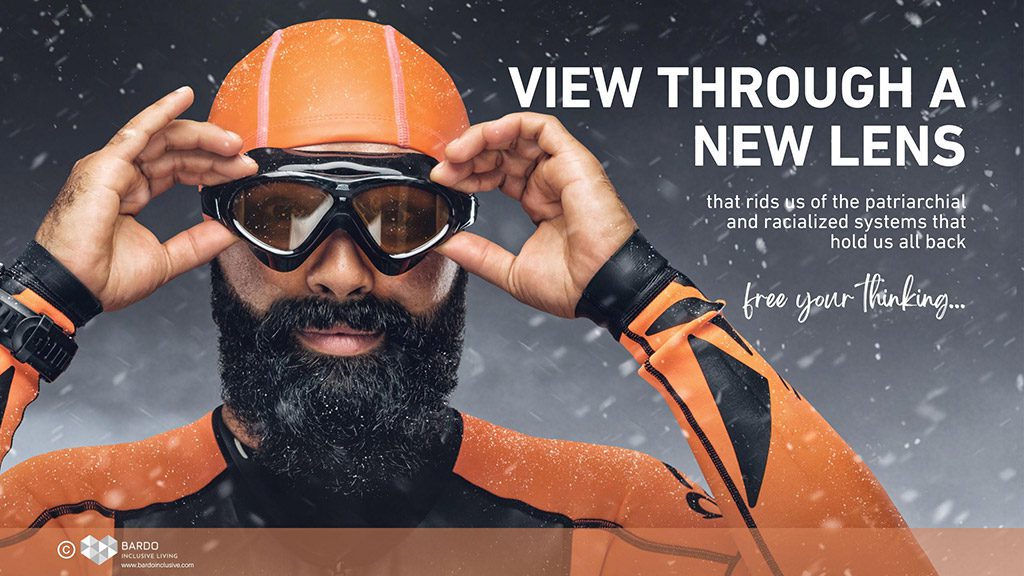
You might ask, ‘But how is the status quo discriminatory? Anyone can learn to dive or take part in discussions. “They” just don’t want it. Isn’t this just some “woke” outlier?!‘
Well, let’s first look at what it means to be “woke”—without the weaponised interpretation that those in positions of power and privilege use to divide us.
To be aware of injustice, particularly social injustice primarily–but not exclusively–around race, is apparently to be “woke.” It is not about being over-sensitive. It is not about liberalism. It is not a tool to amplify polarisation. Wokeness is awareness of the many discriminators, barriers, and blocks that are unseen by those who are not subject to them.
In today’s world there is a need for a truly inclusive culture: a need to interrupt our default thinking. We have to be able to see and address the injustice, and the social burdens some carry, and act to remove these burdens. Achieving this requires creating more proximity to and opportunities for those who are different, who experience life differently, and who have a different known. We need to break free from our echo chamber of homogeneity and actively listen with an open mind and heart. By breaking down our self-imposed barriers, we can start to build empathy, gain insight, and uncover those invisible discriminators. We can create new approaches that help everybody, including ourselves and our industry.
Breaking free from stereotypes and tropes paves the way for us to see the world as it is, instead of how we are. It involves us looking beyond our limited understanding and embracing new knowledge.
DIVERSITY IN DIVING
If you’re interested in thinking deeper about how diversity concepts could inform the diving community of the future, ask yourself some of the following questions:
- How many diving events have you been to that are accessible for those with hearing, vision, or mobility impairments?
- Do you think the diving training materials you’ve encountered would be accessible to people with dyslexia and other comprehension-related challenges?
- Do diving organisations’ visual language, marketing, and artefacts speak to a diverse audience and make people from all backgrounds feel that they belong in the diving community? Or do they reinforce derogatory stereotypes?
- Does diving research adequately address issues impacting women divers?
- Are you aware of adaptive equipment or practices designed for divers with physical disabilities?
Perhaps the most important line of questioning is why some individuals from minority groups (who could be promising divers) don’t participate in diving?
The desire to dive for many in the marginalised populations certainly exists: there are amazing trailblazers in the community already, but they often feel too intimidated to question the majority for fear of being ostracised.
Often conflict avoidance and a desire for cohesion win out over constructive dissent when a largely homogenous group works together. Combined with structural faults, consensus-seeking tendencies can result in insufficient creativity, self-censorship, the illusion of invulnerability, belief in member superiority, collective rationalisation of decisions, stereotypes of outsiders, the illusion of certainty, and pressures on dissenters.
And, ultimately, errors and biases go unchecked. This creates a selective bias in processing information and a failure to recognize risks and develop contingency plans.
Whatever area of diving your work is in, this results in questionable choices, and a lower probability of success. Whether that be in retail opportunities, research outcomes, training, or manufacturing of products.
In reality, the answer to the posed question is another: What incentive is there for minoritized groups to engage with you, your shop, or your product when the industry blatantly shows a lack of care for their needs? This is an observation backed up by some of my conversations with minority divers.
MAKING WAVES – A CHAT WITH CHANGE AGENT ANESTI VEGA
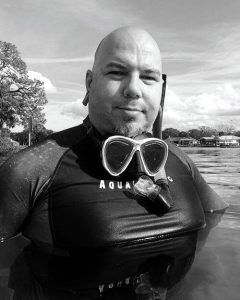
Anesti Vega is an ocean scientist and expedition leader. He recalls how, after struggling to adjust to life after military service and living with post traumatic stress syndrome (PTSD), he looked for purpose in high adrenaline activities. But it was finding neutral buoyancy and trim when diving that provided him with an “ah-ha” moment. Learning to control and focus on his breathwork to perfect his buoyancy and trim provided the serenity and grounding he had been yearning for.
Diving for Anesti started out at the Aquarium of the Bay in San Francisco, where he got to dive with sharks and was introduced to community science projects. Although he acknowledges his privilege of being ‘white passing’ (able to benefit from being perceived as white, although from another racial background) the absence of opportunities within the diving community were very apparent to him.
Having previously worked on issues of social injustice at grassroots organisations, helping them to obtain grants and raise their voice, Anesti was in a unique position to immediately see the invisible discriminators, barriers, and blocks in diving—the areas where diverse individuals’ needs were being ignored.
Recognising this value, Anesti knew he could make a difference. He was able to see the leaks in the diving pipeline, and chose to meet the needs of a diverse audience where they were.
Consider swimming: an overwhelmingly white activity, especially in England, where statistics suggest that 95% of Black adults, 80% of Black children, 93% of Asian adults, and 78% of Asian children don’t swim. Statistics are similar in other parts of the world.

Lack of swimming skills and in-water confidence obviously affect the pipeline feed for potential divers from these communities. So Anesti starts there, teaching water safety and swimming to racially diverse, marginalised, and vulnerable populations. He serves as Scuba Council Chair for Diversity in Aquatics, an organisation that has worked in over 21 different countries, built national and community level partnerships, engaged with more than one million youth annually on water safety, and developed a model to address racism and inequity at swimming pools.
Let’s go deeper: Why are swimming, water sports, and water safety not seen as important or an essential life skill by some minoritized communities? Most of the reasons are baked into the structural inequalities within our society. Cost and specific cultural issues are just two. Textured hair, for instance, can be expensive and time-consuming to maintain, and chlorine and salt can substantially impact textured hair. For people who wear expensive artificial braids or spend time and money on hair treatments, a bit of body boarding or diving may not be a particularly attractive proposition. It’s worth mentioning that while products like the Soul Cap have helped bridge the gap between textured hair protection and swimming, there is still not a diving hood equivalent readily available.
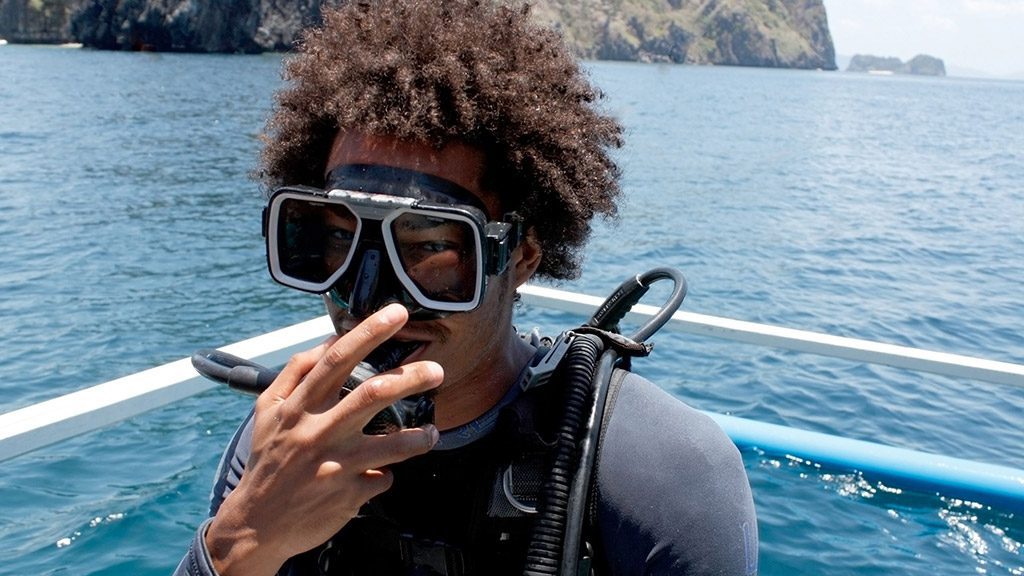
Representation is another barrier. When you don’t see yourself within a community, you think it is not for you. You become blind to the opportunity. This is something that Anesti is also trying to change by raising awareness through speaking engagements; owning his identity both in terms of racial heritage and mental health; and helping to flood the pipeline into diving with more diverse swimmers with a healthy passion for the water.
Stereotypes and racial tropes of Black people having denser bones and being less able to float is also an inhibitor to participation. This mindset is often embedded within Black communities, yet research due to be published soon by the Black Swimming Association in the UK is set to debunk this myth. Shifting limiting beliefs within both the diving sector and within minoritised communities is part of the challenge: this is something Anesti, Diversity in Aquatics, and The Black Swimming Association are trying to do.
There are ways we can all get involved. Partner, volunteer, book diverse speakers for events, or contribute to an inclusion-focused charity.
Anesti is a true hero for me. From a homeless teenager to a PhD in love with science, his story is a true inspiration. It is no wonder he has achieved so many awards, including being named 2021 Sea Hero of the Year by Scuba Diving Magazine. And his legacy will last: he set up a scholarship to fund diverse divers each year with money awarded to him by Seiko.
CODE NOIR – DISCOVERING SUNKEN SHACKLES
The legacy of the Transatlantic Slave Trade can still be seen across the globe, specifically in the Western world; racial bias and discrimination remain embedded within society and compromise equity, opportunity, and justice.
As an uncomfortable history for many, discussions about the Transatlantic Slave Trade are often quite difficult and polarising. One individual that seeks to contribute to a new era of inquiry, truth-telling, and reckoning with this painful history, is Ken Stewart. Ken is the founder of the Nashville, Tennessee–based non-profit Diving With a Purpose. They have a special focus on the protection, documentation, and interpretation of African slave trade shipwrecks and the maritime history and culture of African Americans.

The organisation is dedicated to the conservation and protection of submerged heritage resources and provides education, training, certification, and field experience to Black adults and youth in maritime archaeology and ocean conservation.
Ken was inspired by Dr. A. Jose Jones, who, after being contacted by many Black scuba divers asking to dive with him (as he was one of the first African-Americans to become a certified diver), started the National Association of Black Scuba Divers (NABS). The purpose of the group was to foster camaraderie among African-American divers and address their unique problems and concerns. There are now over 2,000 members internationally.
Whilst working on a documentary about the slave ship the Guerrero with Karuna Eberl, Ken met archaeology expert Brenda Lanzendorf from Florida’s Biscayne State Park. There were a lot more slave ships beyond the Guerrero that needed to be documented, so Ken and Brenda teamed up. Recruiting NABS divers, they started to ‘Dive with a Purpose,’ and, as one participant described it, “Visit the souls of their ancestors.”
Sadly, Brenda passed away, but Ken and Diving with Purpose continue to carry her vision forward. They create pathways for Black student divers. Working in partnerships, they have uncovered many slave ships and been able to discover the stories of ancestors from different ethnic groups. They also share their findings with the current generation, informing relatives that they have found their families and providing opportunities for healing, symbolic gestures, and historical connection. As one participant observed, “So much healing comes from the community that comes out of humanising their stories.”
Diving with Purpose provides a vehicle to ask the questions that have not been asked. Over 1,000 vessels were shipwrecked carrying slaves, but only a handful have been identified. There is still much work to be done in this area, contributing to social responsibility, our understanding and reckoning of the past and how that influences the future.
As Ayana Omilade Flenellen, Co-Founder of the Society of Black Archaeologists stated: “There is a rise in the interest and study of African history…. but no real space made for people that look like us.” The latter part of that sentence is a sobering statement: that, in 2023, there is still a feeling that Black individuals are not provided with a space to authentically belong within the diving community. Segregation is, woefully, still alive and well.
If you want to find out more about the Transatlantic Slave Trade, the Equal Justice Initiative’s report makes enlightening reading.
THE BUSINESS CASE FOR INCLUSION
Whenever discussing anything associated with Justice, Equality, Diversity, and Inclusion (JEDI), there are three cases that highlight the need for us all to see change. The first is the fact that equal opportunity is quite simply the right thing to do. And that has to be the most important point. Secondly, there is the legal case, where legislation in many countries now makes discrimination illegal for organisations and naivety is not an excuse. The final case is the business case—embracing change can be very good for business. It can open new markets, increase revenues, and broaden the appeal of your offering.
Take a diver training agency, for example. How truly inclusive is the training that they offer? Using a cookie-cutter approach with the occasional nod to inclusion with a token diverse face in training materials or social media content is missing the point. Without a true understanding of the often-unseen structural, operational, and cultural barriers in place, diver training organisations may remain unattractive to many minoritised divers. Meeting diverse needs can be very good for business – materials and approaches that embrace inclusion can help such businesses to tap into hitherto hard to reach markets. The net result is more divers entering the sport that we all love, greater retention, and revenue generation.
Even training materials could address hidden barriers. We are all cognitively diverse and approach things differently; are training materials adaptive enough for all to participate, or do they force individuals into one way to learn?
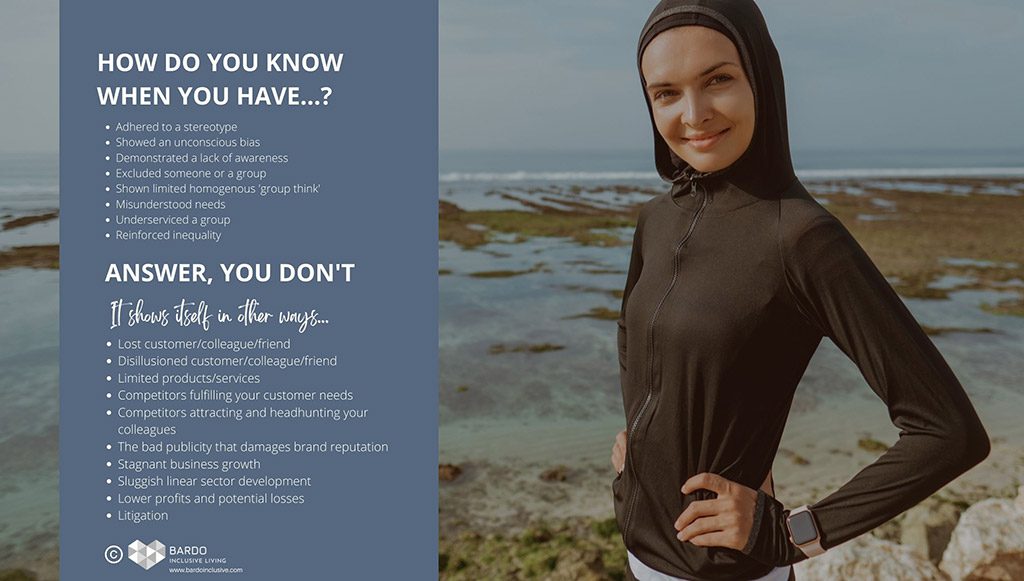
By its very nature, diving is heavily laden with physics, complicated equations and mathematics—aspects of diving theory that can act as barriers to understanding for even the sharpest students. So-called ‘battlefield calculations’ are very in vogue, but it’s important to appreciate that not everyone is comfortable with such on-the-fly methods. This does not mean individuals are not capable, just that they may require a different approach.
Other issues arise around the use of inclusive language and ensuring content demonstrates intercultural competence. By ensuring that content is transferable to different cultures, we can improve communication and collaboration. Through considering the seven components of cultural competency, agencies can fully understand their place within a global market and make an impact on their dominant culture, which may be a barrier to some.
- Beliefs and worldview — How people from different cultures and backgrounds see the world and their place in it
- Communication styles — How people convey information, such as directly or indirectly, based on their culture
- Formality — The manners and etiquette people use when communicating with people of different statuses and showing respect
- Hierarchy — The ways in which cultures structure their social and professional leadership, such as horizontally or vertically
- Perceptions of time — How people discern deadlines, such as on a fixed or flexible basis, as well as goals, such as short or long term
- Values and priorities — The different principles and concepts that people find most important, such as loyalty, teamwork, or work-life balance
- Uniqueness and individuality — An understanding that each person is unique and should be perceived as individuals.
Societies’ needs are changing as diversity topics receive more exposure. Making efforts to diversify diving quite simply helps to ensure the resilience and relevance of the sector.
MAKING A DIFFERENCE

UK based company, Fourth Element, is actively embodying its values by promoting diversity and inclusivity in the diving community. They are looking to address systemic barriers rooted in gender and racial biases and are working to increase visibility for divers from underrepresented groups.
Recently, Fourth Element partnered with Love the Oceans, a community-led conservation organisation in Mozambique. This initiative is an ongoing commitment to highlight the achievements and stories of divers from all minorities.
According to Jim Standing, co-founder of Fourth Element, “Diving enables us to enter the ocean and it should be accessible to as many people as possible. By collaborating with projects like Love the Oceans, along with other similar initiatives, we are showing that not only is the ocean a resource that we all need, and need to protect, but also diving should be a sport for everyone.”
INCLUSIVE PRODUCTS
If you were training or advising a diver with a prosthetic leg, would you know of products that could support them, such as the Nibble prosthetic fin?

THIS IS NOT INCLUSION! Don’t just ‘shrink it and pink it‘ for women – understand what women really need to support their diving experiences.
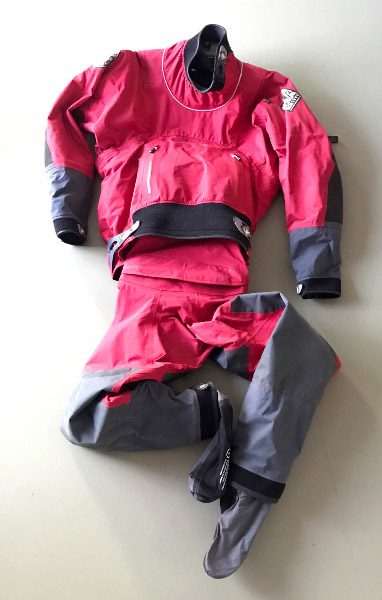
NEW MARKETS AND PRODUCTS
Rather than responding to women’s diving needs by ‘shrinking and pinking’ existing products, (women are not small men, and we don’t all like pink!) perhaps the sector could explore producing items that enhance the diving experience for women. Women are not an anomaly in diving! The key to making diving more accessible to women is working with them to provide opportunities, proximity, and insight.
Inclusive Research
The acclaimed book, Invisible Women – Exposing Data Bias in a World Designed for Men, by author and academic Dr. Caroline Criado Perez, demonstrates the important issue of how invisible women’s physiology is in research and how this impacts everyday life. Male-default data sets can produce life-threatening outcomes when crash test dummies and life-saving equipment, for instance, don’t adequately address women’s unique needs.
For example, Sarah Walsh of Football Australia, recently commented about the number of women in football who suffer from ACL injuries. Her research has concluded that this is not as a result of a deficit in women’s footballing technique, but due to the lack of research into women’s anatomy and the science of product development being based on the default male body. This is an example of the patriarchal system at play. Are women’s bodies considered in fin design? What assumptions are being made about fin development that are based on hard wired thinking which is full of invisible discriminators? How is this impacting female divers?
It is not just women who are invisible within diving products and research. Different ethnicities, faiths, and cultures are often left unseen.
Corporal Balraj Singh was the first turbaned Sikh in the history of the Singapore Navy to undergo and complete the intensive Combat Diver Course (CDC) of the elite Naval Diving Unit (NDU) in 2021.

“While having long hair made it challenging since we spend a lot of time in the water, I am glad to prove that it does not hinder Sikhs from becoming operational divers.”
—Corporal Balraj Singh
Without inclusive thinking and design, where we can hear the voices of diverse experience, we won’t know the needs of every diver. Raising the voices of and being allies to diverse members of the diving community is essential to create products that are genuinely needed.
There are similar challenges for other minoritized groups. With a potential need for waterproof hijabs and niqabs for women of the Muslim faith.
Wa’ed Alma’aytah is a Muslim female diver who wears her hijab whilst leading dives in Aqaba. She is a fabulous role model for Muslim women who want to break the mould and engage with the underwater world.

BREAKING THE PARADIGM – IT STARTS WITH YOU…
Diversity and inclusion are our collective responsibility, and the solution starts decidedly with us. I started this article with one of my favourite quotes, so I am going to end with another, though there is uncertainty over its attribution.
“Until you make the unconscious conscious, it will direct your life and you will call it fate.”
—Carl Jung
With this in mind, we can all start by pausing and thinking about what is hard-wired into our brains and if it is true and helpful. As a thought arises, or as you craft a response, ask yourself, can I contradict that? Is that really true? Is it helpful or based on fear and wanting to belong?
We can continuously self-reflect and try to understand why we think the way we do. We can bring that opinion or belief into the conscious mind, examine and question it, adapting as necessary. It is not fate that a diverse group of divers is not engaging with you or your business; but we can all play a part in changing and opening up opportunities for all.
Structurally, we can help to create an environment where our policies, processes, practices, and products are looked at through an inclusive lens to identify any barriers, biases, or blocks, and start to make them more inclusive.
This is not always easy when we can only see things through our known lens. Working with individuals with lived experience is essential, however, all genders can still uphold a patriarchal system, and all races can uphold a racialised system. So it has to be those that can see the discriminators and are continuously developing that transient inclusive lens.
The need for structural changes might come to light as you audit your statistical data (such as recruitment and promotional pipelines) and recognise how patterns can be attributed to cultural barriers. Providing appropriate governance and adaptive leadership on these issues is essential to making positive change.

Culturally, we can all learn how to be active allies or equality accomplices to the diving community by opening up our echo chambers to more diverse views, developing an awareness of diversity and inclusion, and gaining proximity and insight through actions such as undertaking reciprocal mentoring with a diver from a different background and lived experience.
We can look to sponsor diverse trailblazers into positions of influence and raise their voices within homogenised groups. We can not speak for them or assume we understand their needs.
We can learn to become inclusive leaders with open minds and hearts.
IN CONCLUSION
I expect that there are some readers who found this article uncomfortable. I applaud that. Few changes are made from a position of comfort. For those who read to the end, you probably already had an interest in the topic and knew deep down that as a unique and specialised culture we needed to move forward. To those readers, if you want to know how you can address the inequity you see as a diver, look back at and be inspired by Ken Stewart and Anesti Vega. If we all pledge to do just one thing to support inclusion, we can start to shift toward a future where we can all belong, then diving–and society– can flourish.
DIVE DEEPER
InDEPTH: The Diving Industry Is Run By Middle-Aged White Blokes. Our Future Depends on Making Them Uncomfortable by Alex Griffin
InDEPTH: We Can Be Heroes: Inside the Rebreather Forum 4 imagery by Cristian Pelligrini
NYT: Drowning Is No. 1 Killer of Young Children. U.S. Efforts to Fix It Are Lagging. (JUL 2023) Thirty years of progress in decreasing drowning deaths in the United States appears to have plateaued, and disparities in deaths among some racial groups have worsened.
CDC: CDC Drowning Facts
WHO ARE YOUR DIVING HEROES?
Is there anyone that you would like to see highlighted who does not get the recognition they deserve? Someone we can help to raise the voice of?
If so, contact: [email protected]

GEORGINA BROWN MSc (she/her) is a TEDx Speaker and Award-Winning Equality, Diversity, and Inclusion Practitioner. Founder of BARDO Inclusive, she has over 24 years of experience in diversity and inclusion work. She has supported the British Army, L’Oréal, the UK Home Office, the NHS, global corporations, retail and numerous universities both in the UK and abroad with their inclusive aims. George is passionate about diversifying the outdoor space and adventure sports. She has been involved in the diving community for over 20 years and you will often see her volunteering at diving events around the world. Want to know more about this topic? Feel free to reach out to her through her website or LinkedIn.











